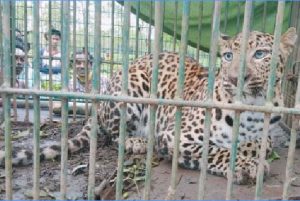 Across India, leopards exist entirely outside protected areas and close to human habitations due to easy availability of prey. According to wildlife biologist Aritra Kshettry, the home range for some of these animals covers forests as well as tea plantations in north Bengal and Assam.
Across India, leopards exist entirely outside protected areas and close to human habitations due to easy availability of prey. According to wildlife biologist Aritra Kshettry, the home range for some of these animals covers forests as well as tea plantations in north Bengal and Assam.
In upper Assam’s tea belt area, especially Tinsukia, Jorhat and Golaghat districts, tea gardens often harbour resident leopard populations, leading to human-leopard encounters during plucking. To drive away leopards, the forest department normally follows the policy of capture and release of the animals. “It has been an established practice as the general belief is that leopards in tea gardens are an aberration and that they should go back to forests,” Kshettry added.
Leopards in tea gardens
Nigel Desouza, the manager of Nonaipara tea estate, about 120 km from Guwahati, said once cubs are born in drains, female leopards keep moving them around and that is when most attacks take place. “These drains are all over the tea estate and help in draining away excess water. Leopards also find easy cover in the Guatemala grass, which is replanted every year on all estates to help increase yields,” he added.
Tea estates are huge and the average size ranges from 550-600 hectares (ha). Many gardens have deployed spotters or chowkidars and they keep an eye on the movement of leopards. There are drum beaters as well, who beat drums when workers move inside for plucking tea leaves. This ensures that leopards move away to a different section. Tea gardens are divided into several sections. For instance, a 400-ha garden may have 50-60 sections.
Manager of Limbuguri tea estate in Tinsukia Vikram Singh said there is a patch inside the garden area which is protected by bamboo plantations. “In that area we reported the presence of four to five leopards in July. When the forest officials were called, they placed a cage. One animal was caught and the rest went away,” he added.
The Lumbuguri garden covers over 700 ha of area and tea plantation covers 400 ha, Singh added. “A team of security guards has been deployed. Whenever they spot leopards in a certain section, pluckers are not put there to avoid encounters. It is a safeguard measure,” Singh explained.
Harshvardhan Singh Jamwal is posted as the manager in Teok estate close to Jorhat. “My garden almost spans 500 ha. Due to deforestation, leopards try to enter tea gardens and lift livestock like goats and cows kept by tea workers in labour quarters.” Sandeepan Bhattacharjee, the assistant manager of Diffloo tea estate about 20 km from the Kaziranaga National Park, however said, though leopards are present, it is not a major issue. “Encountering leopards are rare, but I have seen pugmarks. We carry on awareness drives. My workers have developed a way to start plucking leaves from one side. So, even if an animal is hiding, it moves away.”
Ashok Trivedi, who manages the Boisahabi tea estate in Jorhat, said conflicts are much more reported in the media now. “The conflict is mostly man-made. When a leopard is spotted, there is a lot of hype. Sometimes, people unnecessarily harass the animal. In a bid to escape and save itself, it springs, thus unnecessarily hurting someone,” he said. Trivedi feels that trapping is not an effective solution. Most forest officials do their jobs in a routine way and are not quite sensitive, he pointed out.
Awareness campaigns
As part of sensitisation drives to educate people, awareness campaigns are being organised in Guwahati. One such person, who regularly conducts such campaigns, is conservationist Mubina Akhtar. Akhtar hails from Golaghat in upper Assam dotted with tea gardens. “Leopards are highly adaptable. In upper Assam, there are lots of tea gardens, and so, interactions have also become severe,” she said.
According to Akhtar, in the past five to ten years, most human-leopard interactions have taken place. Data collected by her under the Living with Leopards programme shows in 2019, 16 leopards were killed in tea estates and villages in upper Assam. In Guwahati, four leopards lost their lives. Compared to that, 12 people were injured. This year till now, 12 leopards have been killed and 13 people injured in upper Assam.
To sensitise people, Akhtar organises campaigns in Guwahati with the help of WWF grant. As part of awareness programmes, posters regarding dos and don’ts are also distributed. The conservationist vouches that things have changed. Since 2017, though leopards have been sighted, people have not tried to harm them or take the law into their hands.
Now, Akhtar wants to take her campaign to upper Assam districts, especially in Golaghat, where in the past three to four years, people have killed six-seven leopards. “Forests are being cleared for tea gardens. In the past three to four years, there has been an increase in cases in tea gardens and people have to be made aware. I also want to move to Tinsukia where there are many encounters,” she said.
Debobroto Sarkar, who used to handle the wild aid division of the Wildlife Trust of India (WTI) based in Noida, said a lot of leopard conflicts used to take place in Maligaon and Kamakhya temple areas of Guwahati back in 2015.
“These two places proved to be good habitats for leopards. Through our local team in Guwahati, we got in touch with conservationist and researcher Mridul Borah, who wanted to start a sensitisation drive. We tried to reach out to women and also conducted sessions with schoolchildren, media and local people,” he added.
Awareness drives have definitely changed the perception of people towards leopards. Even reporting in media has changed to more positive connotations, Sarkar explained.
On his part, Bora said, “I have been studying human-leopard conflicts for a long time. We ignore the basic ecology of leopards. Outside protected areas, they not only live close to human settlements but also give birth to cubs. Their food preference ranges from anything from chicken and pigs to even dogs. About 48 percent of their prey base consists of domestic animals.”
Bora added that there are encounter cases in Guwahati due to the presence of hillocks, green cover and stray dogs. “We have a lot of dairy farms and almost zero livestock protection. Even tea gardens have livestock and thus they are good habitats for leopards.
There is a need to sensitise workers in tea estates. But due to ignorance and policy of tea garden management, we are not welcome. They think workers may start protesting,” he added. Research conducted by Bora and others in Guwahati metro from February 2013 to April 2014 says conflicts are arising due to habitat loss of leopards.
Apart from Akhtar and Bora, a women’s group formed in 2015 by WTI also succeeded in sensitising people. Bora said it was a 10-member group, now functional no more, after three of its members shifted to upper Assam. In 2014, 2015 and 2016 they organised drives in Maligaon and Kamakhya Hills.
letters@tehelka.com













